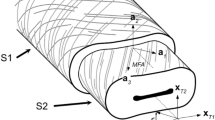Abstract
Friction affects the use of paper in many ways, from the manipulation and slippage control of paper sheets in large industrial machines to rolling and inking transfer in ballpoint pens. Paper is mainly constituted of cellulosic structures, whose contribution to friction is still obscure. In this work, the contribution of cellulose fibers, macrofibrils, and microfibrils to the forces exerted on a nanoscale tip as it moves across the paper surface is addressed. The surface topography of monolucid kraft paper was measured by atomic- and friction-force microscopies. Cellulose fibers and entangled macro- and microfibrils were observed. Their aspect ratios were measured, and their contribution to friction with a nanoscale silicon tip was determined. The forces opposing the motion of the tip were attributed to tripping and intermolecular friction. The former was measured mainly at extended contacts at the lateral surface of cellulose fibers, while the latter was mainly observed at point contacts on top of macro- and microfibrils.





Similar content being viewed by others
References
Alava M, Niskanen K (2006) The physics of paper. Prog Rep Phys 69:669–723
Bastidas JC, Venditti R, Pawlak J, Gilbert R, Zauscher S, Kadla J (2005) Chemical force microscopy of cellulosic fibers. Carbohydr Polym 62:369–378
Bhushan B, Wei G, Haddad P (2005) Friction and wear studies of human hair and skin. Wear 259:1012–1021
Bogdanovic G, Tiberg F, Rutland MW (2001) Sliding friction between cellulose and silica surfaces. Langmuir 17:5911–5916
Chinga-Carrasco G (2011) Cellulose fibres, nanofibrils and microfibrils: the morphological sequence of MFC components from a plant physiology and fibre technology point of view. Nanoscale Res Lett 6:417–423
Chinga-Carrasco G, Yu Y, Diserud O (2011) Quantitative electron microscopy of cellulose nanofibril structures from eucalyptus and pinus radiata kraft pulp fibers. Microsc Microanal 17:563–571
Gustafsson J, Ciovica L, Peltonen J (2003) The ultrastructure of spruce kraft pulps studied by atomic force microscopy (AFM) and X-ray photoelectron spectroscopy (XPS). Polymer 44:661–670
Hanley SJ, Giasson J, Revol J-F, Gray DG (1992) Atomic force microscopy of cellulosic microfibrils: comparison with transmission electron microscopy. Polymer 33:4639–4642
Huang F, Li K, Kulachenko A (2009) Measurement of interfiber friction force for pulp fibers by atomic force microscopy. J Mater Sci 44:3770–3776
Li Y, Rojas OJ, Hinestroza JP (2012) Boundary lubrication of PEO-PPO-PEO triblock copolymer physisorbed on polypropylene, polyethylene, and cellulose surfaces. Ind Eng Chem Res 51:2931–2940
Liu E, Blanpain B, Celis JP (1996) Calibration procedures for frictional measurements with a lateral force microscope. Wear 192:141–150
Meier H (1962) Chemical and morphological aspects of the fine structure of wood. Pure Appl Chem 5:37–52
Meyer E, Overney RM, Dransfeld K, Gyalog T (eds) (1998) Understanding of lateral forces. In: Nanoscience: friction and rheology on the nanometer scale. World Scientific Co., Singapore, pp 123
Mizuno H, Kjellin M, Nordgren N, Pettersson T, Wallqvist V, Fielden M, Rutland MW (2006) Friction measurement between polyester fibres using the sibre probe SPM. Aust J Chem 59:390–393
Mizuno H, Luengo GS, Rutland MW (2013) New insight on the friction of natural fibers. Effect of sliding angle and anisotropic surface topography. Langmuir 29:5857–5862
Rutland MW, Carambassis A, Willing GA, Neuman RD (1997) Surface force measurements between cellulose surfaces using scanning probe microscopy. Colloids Surf A Physicochem Eng Aspects 123:369–374
Schmied FJ, Teichert C, Kappel L, Hirn U, Schennach R (2012) Analysis of precipitated lignin on kraft pulp fibers using atomic force microscopy. Cellulose 19:1013–1021
Simola-Gustafsson J, Hortling B, Peltonen J (2001) Scanning probe microscopy and enhanced data analysis on lignin and elemental-chlorine-free or oxygen-delignified pine kraft pulp. Colloid Polym Sci 279:221–231
Stiernstedt J, Nordgren N, Wågbergc L, Brumer H III, Gray DG, Rutland MW (2006) Friction and forces between cellulose model surfaces: a comparison. J Colloid Interface Sci 303:117–123
TAPPI (1990) Coefficients of static and kinetic friction of uncoated writing and printing paper by use of the horizontal plane method. Technical association of pulp and paper industry T 549 pm-90
TAPPI (2001) Coefficient of static friction (slide angle) of packaging and packaging materials (including shipping sack papers, corrugated and solid fiberboard) (inclined plane method). Technical association of pulp and paper industry T 815 om-01
Yan L, Li W, Yang J, Zhu Q (2004) Direct visualization of straw cells walls by AFM. Macromol Biosci 4:112–118
Yan YD, Dong S, Sun T (2005) 3D force components measurement in AFM scratching tests. Ultramicroscopy 105:62–71
Zauscher S, Klingenberg DJ (2001) Friction between cellulose surfaces measured with colloidal probe microscopy. Colloids Surf A Physicochem Eng Aspects 178:213–229
Zhang Z, Fletcher IW, Hurley CR, Boardman C, Doylec P, Leggett GJ (2010) Morphological and quantitative frictional measurements of cotton fibres using friction force microscopy. J Mater Chem 20:8531–8538
Acknowledgments
This work was partially supported by the Fundação de Amparo à Pesquisa do Estado de Rio de Janeiro (FAPERJ) and Conselho Nacional de Desenvolvimento Científico e Tecnológico (CNPq).
Author information
Authors and Affiliations
Corresponding author
Ethics declarations
Conflict of interest
The authors declare that they have no conflict of interest.
Rights and permissions
About this article
Cite this article
Machado, M., Souza, S.M.A.G.U., Ferreira Morgado, A. et al. Influence of cellulose fibers and fibrils on nanoscale friction in kraft paper. Cellulose 23, 2653–2661 (2016). https://doi.org/10.1007/s10570-016-0953-7
Received:
Accepted:
Published:
Issue Date:
DOI: https://doi.org/10.1007/s10570-016-0953-7




